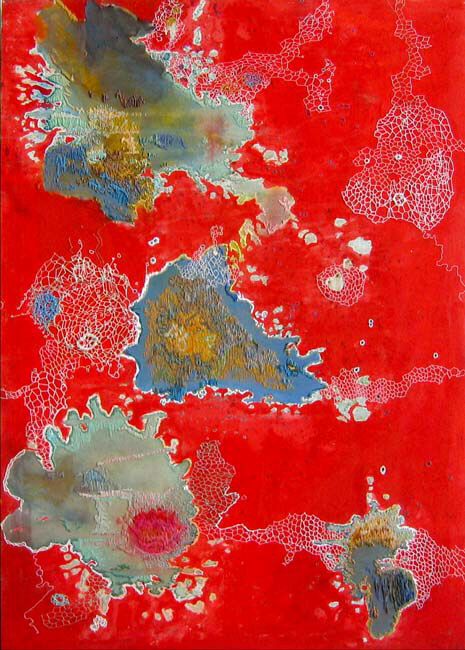
I met Nava Lubelski on an artist’s retreat in Johnson, Vermont, at the first supper of the retreat. Over fresh baked bread, we talked about our work, and, as there often is in non-Jewish circles, there was curiosity about the Jewish themes dominating my work. Nava asked me squarely: “why are you interested in Jewish themes?”
Nava did not identify herself as Jewish, yet her work can easily be read as an extension of so many of our bubbes’ and zaydes’ experiences in the new world. Nava collects old fabrics, shmatas: tablecloths, napkins, dresses, all stained. Whether the stain is identifiable or not, it becomes the inspiration and source of Nava’s expressive journey.
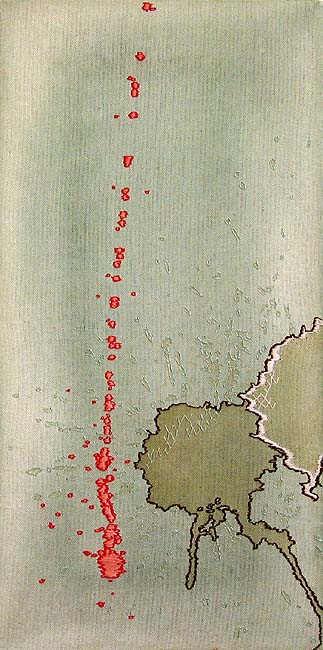
Most of us would balk at the prospects of dealing with discoloration on our clothes, but Nava celebrates it, fastidiously clinging to the forms and random designs that are present, aged, spewed across the fabrics. She creates an obsessive homage through embroidery and stitching. Only lately has she begun to stain the fabrics herself.
Nava’s images are sometimes organic, psychedelic, meditative, virused or violent. Her forms create a candid portrait of a moment stuck in time, long past, and we look on, stuck on it, transfixed on the damage made beautiful or odd.
She got into this process from feeling restless with painting, and so for fun began collaging fabric. Then she became interested in the ideas that sewing opened up in an artistic context. She says, “Painting felt like it was purely form and content because the medium is a given, while sewing could contain ideas just by virtue of the choice to sew and it became fascinating to me to examine what those ideas might be, how they are communicated, etc. And then sewing opened up into more sculptural work, some video, different things, though I am still focused on thread mostly.”
====
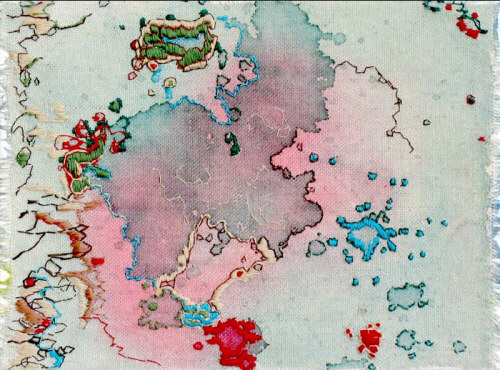
Can the craft of sewing ascend to ‘art’ status? This is a question Nava ponders. No stranger to the artistic life, she finished college and worked in the film industry, then in 2005 received a grant from the New York Foundation for the Arts and a Full Fellowship residency at the Vermont Studio Center in 2006, where we met. Her tongue-in-cheek art history and craft projects book, The Starving Artist’s Way, was published by Three Rivers Press in 2004, is another homage of her moving between high and low culture.
Lubelski isn’t overt about her influences, though she enjoys conceptual artists like Yoko Ono and humorous, obsessive artists like Tim Hawkinson. Arte Povera is something that is close to her heart, especially because of the sewing, but she didn’t discover that movement until she had already started on this kind of work.
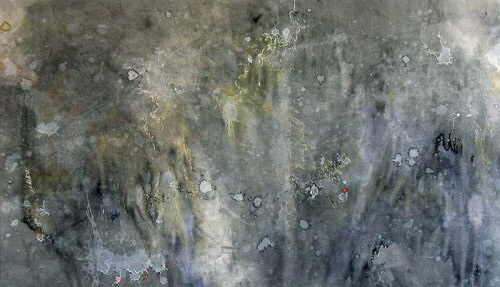
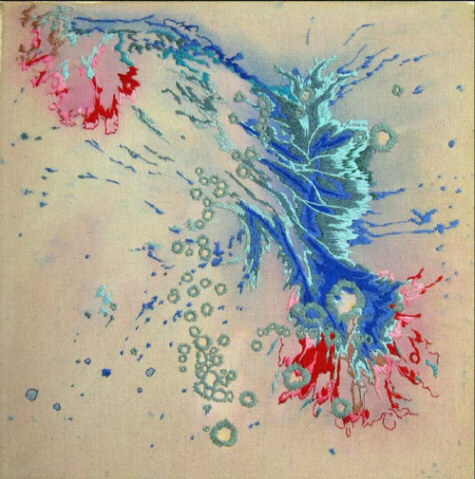
Nava Lubelski was born and raised in New York City where she grew up around Jewish culture, but not much religion. Her father, born in Europe, grew up speaking Yiddish. He emigrated with his parents and other surviving relatives in 1950. She understood a bit of the language and knew Yiddish songs and stories from when they celebrated holidays; puppets and costumes for Purim, Yiddish songs and poems at Passover.
But her family had been secular for many generations on both sides, even back in Europe, so they didn’t go to Temple except for Yom Kippur. Then her parents dragged her to the only place within walking distance, an Orthodox shul she remembers as a glum experience of organized Judaism.
She didn’t associate Hebrew with being Jewish; her culture was Yiddish, and not in what she calls, “the kitschy American way.” Her family was just off the boat and still European. They didn’t have Hanukah bushes or gefilte fish from a jar. She also remembers a lot of sadness from the trauma of the Holocaust. There were many memorial markers in her Jewish experience. She relays that her family would stand up to sing the Yiddish “song of the partisans” at Passover.
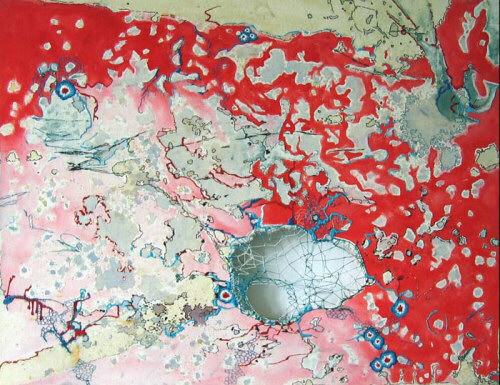
====
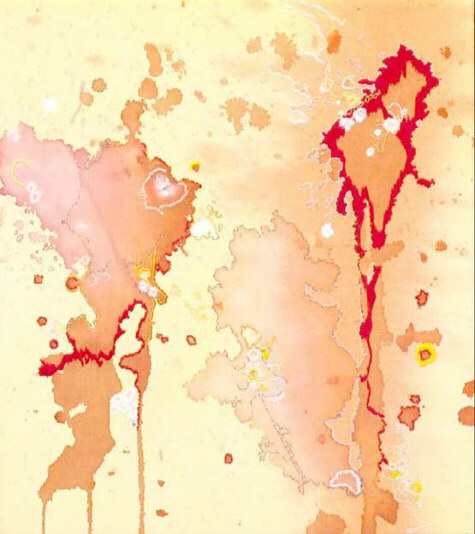
Her work is deceptively simple. Actually, the task of sewing thin threads is often painstaking, and spending hours in the studio, half listening to books on tape, is routine. Yet the end product is not so dissimilar to the source material: remnants of a person’s clumsy or wound-inflicted moment, a family’s meal or some other questionable activity that produces ‘stains’. It is that moment that is remembered or discarded that Nava picks up on, cherishing the time to heal and fix. Her images, while lovingly created are almost violent signposts, casts and bandages smothering the original marks, like a smaller-scale, crafted Christo.
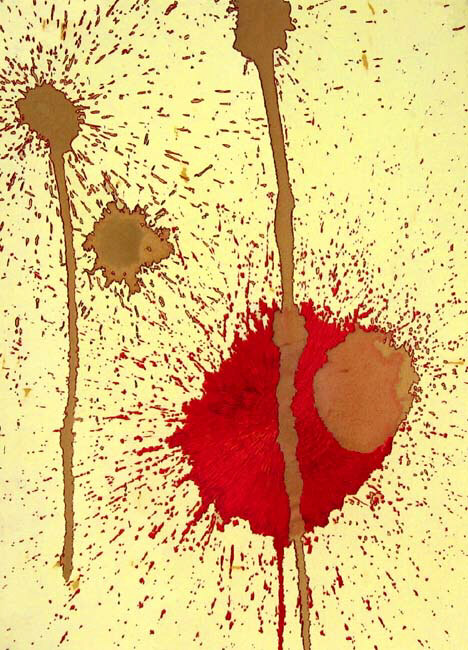
In many of her works, I sense an affinity to the broken glass at a Jewish wedding. This glass-shattering represents, among other things, that marriage, like life, is a fusion of the celebratory and the challenges. Here, Lubelski’s fusion of color and form shards splayed across the ‘canvas’ prompt our losing sight of the original intention or form, as it becomes subsumed in the newer art work. While a new order and balance is created, undeniably a mutation of sorts.
– Bara Sapir








Outstanding post, you have pointed out some excellent points , I as well believe this s a very good website.
I simply had to say thanks again. I am not sure the things that I could possibly have carried out without these ways shared by you on my area. It was a very daunting dilemma in my view, however , encountering your professional manner you treated that made me to weep for contentment. I am thankful for the help and expect you comprehend what an amazing job that you’re putting in educating many people through a blog. Most likely you haven’t met any of us.